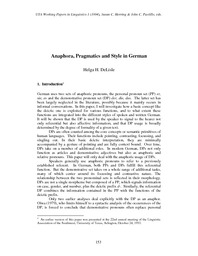
ATTENTION: The works hosted here are being migrated to a new repository that will consolidate resources, improve discoverability, and better show UTA's research impact on the global community. We will update authors as the migration progresses. Please see MavMatrix for more information.
Show simple item record
| dc.contributor.author | DeLisle, Helga H. | |
| dc.date.accessioned | 2008-11-19T00:46:38Z | |
| dc.date.available | 2008-11-19T00:46:38Z | |
| dc.date.issued | 1994 | |
| dc.identifier.citation | DeLisle, Helga H. 1994. Anaphora, pragmatics and style in German. UTA Working Papers in Linguistics 1.153-159. | en_US |
| dc.identifier.uri | http://hdl.handle.net/10106/1193 | |
| dc.description.abstract | **Please note that the full text is embargoed** ABSTRACT: German uses two sets of anaphoric pronouns, the personal pronoun set (PP) er, sie, es and the demonstrative pronoun set (DP) der, die, das. The latter set has been largely neglected in the literature, possibly because it mainly occurs in informal conversations. In this paper, I will investigate how a basic concept like the deictic one is exploited for various functions, and to what extent these functions are integrated into the different styles of spoken and written German. It will be shown that the DP is used by the speaker to signal to the hearer not only referential but also affective information, and that DP usage is broadly determined by the degree of formality of a given text. | en_US |
| dc.language.iso | en_US | en_US |
| dc.publisher | Linguistics & TESOL | en_US |
| dc.subject | Anaphora | en_US |
| dc.subject | German language | en_US |
| dc.subject | Style | en_US |
| dc.subject | Pragmatics | en_US |
| dc.subject | Language variety | en_US |
| dc.title | Anaphora, pragmatics and style in German | en_US |
| dc.type | Article | en_US |
| dc.type | Working Paper | en_US |
Files in this item
- Name:
- 153-159-delisle.pdf
- Size:
- 58.09Kb
- Format:
- PDF
This item appears in the following Collection(s)
Show simple item record


